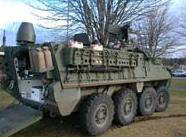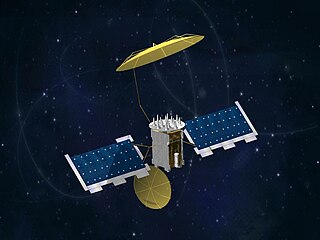
Satcom on the Move (SOTM), or satellite communications on the move, is a phrase used in the context of mobile satellite technology, specifically relating to military ground vehicles, Maritime and Airborne platforms. The basic principle behind Satcom On The Move is that a vehicle equipped with a satellite antenna is able to establish communication with a satellite and maintain that communication while the vehicle is moving.

In the context of spaceflight, a satellite is an artificial object which has been intentionally placed into orbit. Such objects are sometimes called artificial satellites to distinguish them from natural satellites such as Earth's Moon.

A military is a heavily-armed highly-organised force primarily intended for warfare, also known as an armed force, typically officially authorized and maintained by a sovereign state, with its members identifiable by their distinct military uniform. It may consist of one or more military branches such as an Army, Navy, Air Force and in certain countries, Marines and Coast Guard. The main task of the military is usually defined as defence of the state and its interests against external armed threats. Beyond warfare, the military may be employed in additional sanctioned and non-sanctioned functions within the state, including internal security threats, population control, the promotion of a political agenda, emergency services and reconstruction, protecting corporate economic interests, social ceremonies and national honor guards. For a nation's military may function as a discrete subculture within a larger civil society, through the development of separate infrastructures, which may include housing, schools, utilities, logistics, health and medical, law, food production, finance and banking.

A vehicle is a machine that transports people or cargo. Vehicles include wagons, bicycles, motor vehicles, railed vehicles, watercraft, amphibious vehicles, aircraft and spacecraft.
Contents
Modern Military Operations often employ commercial satellites to fulfill theater capacity requirements. However, as modern military warfare is highly asymmetric and mobile, military units desire a SATCOM-on-the-move system. Currently, military units procure this capability from SOTM vendors such as INSTER Getsat, EM Solutions, Alico Systems, Boeing, Gilat Satellite Networks, Comtech Mobile, Datapath, General Dynamics SATCOM Technologies, iDirect, Inmarsat (BGAN), L3, Raytheon, Exelis or ViaSat. More recently Spectra Group (UK) Ltd has introduced SlingShot - a lightweight unit that converts existing tactical radios to SATCOM frequencies, offering a straightforward and cost-effective way to achieve tactical, secure, satcom on the move for those using UHF and VHF radios Comparison between these systems is difficult due to the differences between the technologies and service offerings. Military procurements might benefit from a common set of system requirements from which to evaluate different systems and product offerings. This article presents a survey of the SOTM market, product offerings, and technologies. It concludes with a summary of system technical requirements and drivers for the operation of MILSATCOM-on-the-Move over commercial satellite systems.
Gilat Satellite Networks is a public company headquartered in Israel that develops and sells VSAT satellite ground stations and related equipment. Its shares are traded on the NASDAQ Global Select Market and on the Tel Aviv Stock Exchange.
SATCOM on the move (otm) is currently fielded-Ka band-via the WIN-T program. This WIN-T (General Dynamics/BAE developed system) solution is by means of open loop tracking using an Internal Navigation System (INS). A better solution is closed loop tracking using a phased array antenna. Two Israeli companies have such systems. For example, GetSat has many arrays for Ka/Ku bands SATCOM otm. One of the issues with an open loop solution is the point accuracy obtained. Both the Army WIN-T and the Marines need to rethink SATCOM otm solutions. MIL-STD-188-164 provides some guidance.
One of the problems is SATCOM is not that secure. For example both China and Russia have or will have capability to take out our satellites. HF radios can provide beyond line sight capability. The Marines recognized this; this might have affected their thinking about a mobile command center using SATCOM otm. Note the Marines fielded a static command center which is basically limited by line sight radios. This Marine Corps UOC/COC takes several hours to tear down and setup.















